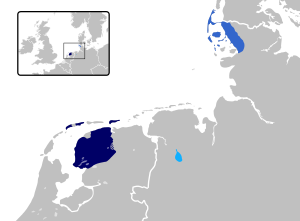Frisian language: Difference between revisions
Jump to navigation
Jump to search

imported>Michel van der Hoek m (typo) |
George Swan (talk | contribs) (add image) |
||
| (5 intermediate revisions by 4 users not shown) | |||
| Line 1: | Line 1: | ||
{{subpages}} | {{subpages}} | ||
''Frisian'' is a [[ | [[File:Frisian languages in Europe.svg | thumb | [[West Frisian]], [[North Frisian]] and [[Saterland Frisian]].]] | ||
'''Frisian''' is a West [[Germanic language]] spoken in the Dutch province of Friesland (Fris. ''Fryslân'') and in a few small areas in northern Germany.<ref name=PositionFrisian/> It is commonly divided into three dialect areas: | |||
* West Frisian (the dialect spoken in the [[Netherlands]]); | * West Frisian (the dialect spoken in the [[Netherlands]]); | ||
| Line 8: | Line 9: | ||
The language is closely related to [[English language|English]] and [[Dutch language|Dutch]]. Through long contact with Dutch, the West-Frisian dialects have adopted many elements from Dutch in [[syntax]] and vocabulary. East Frisian and North Frisian are endangered as the number of speakers has dwindled rapidly in the twentieth century. | The language is closely related to [[English language|English]] and [[Dutch language|Dutch]]. Through long contact with Dutch, the West-Frisian dialects have adopted many elements from Dutch in [[syntax]] and vocabulary. East Frisian and North Frisian are endangered as the number of speakers has dwindled rapidly in the twentieth century. | ||
== | ==References== | ||
{{Reflist|refs= | |||
{{cite news | |||
| url = | |||
| title = | |||
| work = | |||
| author = | |||
| date = | |||
| page = | |||
| location = | |||
| isbn = | |||
| language = | |||
| trans-title = | |||
| archiveurl = | |||
| archivedate = | |||
| accessdate = 2022-08-19 | |||
| url-status = live | |||
| quote = | |||
}} | |||
</ref> | |||
{{cite news | |||
| url = | |||
| title = | |||
| work = | |||
| author = | |||
| date = | |||
| page = | |||
| location = | |||
| isbn = | |||
| language = | |||
| trans-title = | |||
| archiveurl = | |||
| archivedate = | |||
| accessdate = 2022-08-19 | |||
| url-status = live | |||
| quote = | |||
}} | |||
</ref> | |||
{{cite news | |||
| url = | |||
| title = | |||
| work = | |||
| author = | |||
| date = | |||
| page = | |||
| location = | |||
| isbn = | |||
| language = | |||
| trans-title = | |||
| archiveurl = | |||
| archivedate = | |||
| accessdate = 2022-08-19 | |||
| url-status = live | |||
| quote = | |||
}} | |||
</ref> | |||
<ref name=PositionFrisian> | |||
{{cite journal | |||
| url = http://wjheeringa.nl/papers/tdg03.pdf | |||
| title = The Position of Frisian in the Germanic Language Area | |||
Charlotte Gooskens and Wilbert Heeringa | |||
| work = | |||
| author = | |||
| date = | |||
| page = | |||
| location = | |||
| isbn = | |||
| language = | |||
| trans-title = | |||
| archiveurl = | |||
| archivedate = | |||
| accessdate = 2022-08-19 | |||
| url-status = live | |||
| quote = <!-- The Germanic branch of the Indo-European languages has a large number of speakers, approximately 450 million native speakers, partly due to the colonization of many parts of the world. However, the number of different languages within the Germanic group is rather limited. Depending on the definition of what counts as a language there are about 12 different languages. --> Traditionally, they are divided into three subgroups: East Germanic (Gothic, which is no longer a living language), North Germanic (Icelandic, Faeroese, Norwegian, Danish, and Swedish), and West Germanic (English, German, Dutch, Afrikaans, Yiddish, and Frisian). | |||
}} | |||
</ref> | |||
}} | |||
Revision as of 12:49, 19 August 2022
Frisian is a West Germanic language spoken in the Dutch province of Friesland (Fris. Fryslân) and in a few small areas in northern Germany.[1] It is commonly divided into three dialect areas:
- West Frisian (the dialect spoken in the Netherlands);
- East Frisian (spoken in two neighboring municipalities in Saterland in the German Land of Lower Saxony; also known as Sater Frisian);
- North Frisian (spoken on the northwestern coast of the German Land of Schleswig-Holstein near the Danish border, and on the islands off the coast).
The language is closely related to English and Dutch. Through long contact with Dutch, the West-Frisian dialects have adopted many elements from Dutch in syntax and vocabulary. East Frisian and North Frisian are endangered as the number of speakers has dwindled rapidly in the twentieth century.
References
- ↑ [http://wjheeringa.nl/papers/tdg03.pdf "The Position of Frisian in the Germanic Language Area Charlotte Gooskens and Wilbert Heeringa"]. Retrieved on 2022-08-19. “Traditionally, they are divided into three subgroups: East Germanic (Gothic, which is no longer a living language), North Germanic (Icelandic, Faeroese, Norwegian, Danish, and Swedish), and West Germanic (English, German, Dutch, Afrikaans, Yiddish, and Frisian).”
